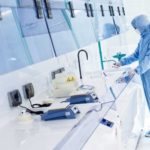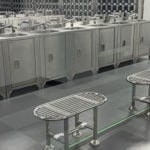The majority of contamination within aseptic processing cleanrooms involves personnel. Proper application of gowns, hygiene, and proper workflow can often eliminate the majority of mix-ups and contamination.
Improper garments, operator technique, and protocol documentation are all leading causes of FDA inspection warnings. Below are some real-world examples of FDA infractions noted within publicly available documents.
What Are Some Real Examples of FDA Infractions in Aseptic Processing Cleanrooms?
- “The clean room operator was observed re-using coveralls that were hanging on a hook in the anteroom.”
- “Your clean room is maintained in a manner that could lead to product contamination. We observed the following clutter within the ISO Class 7 environment including a dispenser of clear adhesive tape, supply bins with various articles, and equipment that were not utilized during filling operations.”
- “We observed the gowning practices of the pharmacist prior to the production. X entered the sterile production area wearing a single pair of non-sterile gloves. Within the clean room X donned a second pair of gloves, sterile latex, powder free. When extended X’s arms to ensure that the fingers filled the appropriate position, the pharmacist’s bare wrist and forearm were exposed to the ISO 7 clean room environment.”
- “Your firm does not receive or review certificates of analysis showing sterility for the sterile containers, such as vials used for sterile drug products.”
Who Enforces Aseptic Processing Protocol in the US?
USP enforcement is maintained by two organizations in the United States:
The Food and Drug Administration (FDA)
State Board of Pharmacy.
In the case that techniques, processes, or equipment do not comply with federal or state inspection requirements, facilities must take appropriate action:
- Revising SOP with protocol and procedures that remedy deficiencies
- Obtaining invoices for required supplies
- Create training materials and records for corrective actions
- Observe revised procedure in action
Do All States Require USP Compliance?
Pharmaceutical compounding activities in Illinois do not reference or recognize USP 797 standards. [source]
Facilities must adapt their garbing order to compliance with localized regulations. In states such as Texas, statutory mandates supersede garbing order issued by USP.
What Aseptic Processing Pitfalls are Most Common?
Improper Garbing Order
- Personnel should remove all jewelry, bandannas, coats, hats, jackets, scarves, sweaters, vests)
- Operators should not wear long sleeves shirts, artificial nails, cosmetics, or visible piercings
Improper Handwashing and Hygiene
- Hands and forearms shall be washed to the elbows for at least 30 seconds with soap (either non-antimicrobial or antimicrobial) and water while in the ante-area.
- Hands and forearms to the elbows will be completely dried using either lint-free disposable towels or an electronic hand dryer.
- Antimicrobial scrub brushes are not recommended because they can cause skin irritation and skin damage.
- Antiseptic hand cleansing shall be performed using a waterless alcohol-based surgical following manufacturer’s recommendations.
Improper Gown or Improper Reuse
- A non-shedding gown with sleeves that fit snugly around the wrists and enclosed at the neck is donned.
- Disposable gowns are generally best suited. As noted in the case above, reusable garments could lead to mix ups if not properly discarded after the appropriate time, or reused inappropriately.
Gloves
Gloves are a leading source of contamination when donned too early. Contact with non-sterile sources is primary concern and easily goes unnoticed.
- Once entering the buffer area, hands shall be cleaned again
- Sterile gloves are the last item donned before compounding
- Gloves must not contact non-sterile surfaces or components during activities
Exposed Skin
- All skin must be covered, including wrists and arms.
- Long sleeves are not considered proper coverage
What’s the best way to prevent exposed wrists and arms?
Cleanroom garments with hand loops stabilize function and integrity when in motion.
Failure to Maintain Aseptic Technique
- Aseptic workflow is critical during manipulations of compounded sterile products and parenteral preparations.
- Shoe covers, hair and facial hair covers, face masks/eye shields, and gloves shall be replaced with new ones before re-entering the compounding area
Improper Workflow within Aseptic Manipulation Workstations
- The flow hood should not be used for placement of paper, pens, calculators, or labels
- All sterile compounding within the hood should take place at least six inches into the hood
- Items should never be placed on air grates surfaces between the operator and sterile products, as they may interrupt outward flow of particle contaminants
Failure to retest personnel every 6 months with hands-on demonstration of skills including (source):
- Media fill
- Glove sampling
- Failure to retest personnel every year with a handwritten screening for:
- Methods of preparation
- Calculations
- Policies on hand hygiene and garbing
- Policies on cleaning and disinfection
Failure to Achieve ISO 5 Hood Validation
Best practices after a flow hood is turned off and restarted:
Non-hazardous
- When turned on, an air flow hood must establish air flow for at least 30 minutes before reuse.
Hazardous (USP 800)
- Biological safety hoods with negative pressure and external ventilation require 4 hours of runtime and cleaning before use.
- Read more: Proper cleaning of biological safety fume hood workstations
Simple Ways to Reduce the Complexity of FDA Inspections or Observations
When a particular garment is a cause for concern, inspectors will request a host of data including SDS sheets, sources, training documentation, and certificates of sterility or analysis. Sourcing dozens of invoices and data sheets from potentially dozens of vendors becomes an overwhelming task alongside revisions to SOPs, updating training materials, or rooting out sources of contamination.
We help facilities simplify their consumables supply chain and consolidate vendor resources into one invoice, one point of contact. Some industrial distribution companies attempt cleanroom market penetration with little knowledge of the application, the product, or the cleanroom environment in question. PAC provides in-house specialists, end-to-end product support, localized delivery, and entrenched manufacturing partnerships.
Our warehouses across the Americas help you get in-stock products faster, with dedicated application and sales support professionals on hand everyday in the case that an inspection requires compliance updates or a source trace. Cleanroom supply chain managers often reach out to us when they are having difficulty identifying a replacement product, when stock becomes inaccessible, or when their current vendor becomes increasingly difficult to work with.
While USP 797 provides a dedicated order for personal cleansing and garbing, these specifications may change according to state regulation. For help regarding localized requirements, most locations benefit from contacting a cleanroom applications specialist.

Related Posts
-
View Solutions Inspection Microscopes
Get a close up look at high-quality microscopes, LED magnifiers, and inspection devices from View Solutions.
-
Get 10% Off The Rolls-Royce of Stereo Inspection
Lynx EVO Eyepiece-less microscopes allow operators use of eyeglasses or safety glasses when inspecting or observing through the viewer. Floating stage (option) provides sensitive control and accurate sample inspection. Ideal for inspecting fragile samples, or…
-
What's the Difference Between Sterile and Aseptic Technique?
Are the terms sterile and aseptic used interchangeably? Is a cleanroom sterile? What is aseptic processing?
-
Electropolishing Standards and Guidelines
Reprinted with permission by Terra Universal, Inc. Overview This document provides a description of the electropolishing (EP) procedures performed by Terra Universal. It also specifies a series of criteria for evaluating the integrity and cleanliness…
-
Stainless Steel Tables for Sterile Processing
Learn more about the requirements of stainless steel tables during sterile processing.
-
Gowning Room Design – Guidelines, Anterooms, and ISO Classification
A gowning room has many variables. There is no mathematical formula when determining the features, surfaces, and HVAC requirements best suited for your application. Space requirements, volume of operators, aseptic workflows, material choice, and even…










